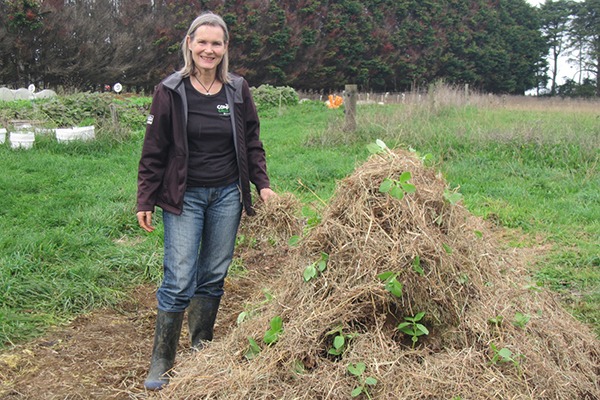Creating a Hugelkultur Raised Garden Bed – Mulching
It’s time for step 9 – mulching, as Jennifer builds a hugelkultur raised garden bed at her property.
Step 9 – Adding mulch
To protect the soil and the seedlings I chose to mulch my hugelkultur bed. I wanted something natural that would provide a protective cover for my soil and around my seedlings that would decompose over time and feed the soil.
I had a homemade bale of hay handy so I used that. I pulled hay out of the bale and placed it around and between the seedlings. Sometimes the hay covered part of the seedling but I was mindful to allow sunlight to reach the leaves.

Mulches have many functions: to retain moisture in the soil, moderate the temperature of the soil, reduce erosion of the soil, suppress the growth of weeds, and protect plants.
For a steep hugelkultur bed, reducing erosion and protecting the seedlings are important. I hope the straw will help with this. The other functions aren’t as important for a hugelkultur bed. Suppressing weeds and moderating soil temperature would be useful. As the logs retain moisture the use of mulch for moisture retention is less important.
There are many other natural mulch materials you could use to cover your soil. These include: paper/cardboard, compost, leaves, wood chips, grass clippings, straw (similar to hay which I used), coffee grinds, bark, sawdust or wood shavings, shells, or wool.
Paper and cardboard are readily available and could be shredded and used as a mulch.
Compost can be used as a mulch but I prefer to cover my compost (and worm castings too) with soil to retain the full benefit of the nutrients. Remember, Compost Collective has free workshops right around Auckland, all about composting.
Leaf mulch could work well. My dead leaves need time to break down before they will be ready to use as a mulch that would stay on the steep sides of the hugelkultur bed.
I could have chipped some wood to create wood chips but I felt the hugelkultur bed already had enough wood in the logs.
I used grass clippings as a layer in the hugelkultur bed. In hindsight perhaps this could have been better used as a mulch at the end?
I didn’t have enough organic coffee grounds to mulch the whole bed but if I had thought ahead and saved them up I could have had enough.
Similarly, I didn’t have enough bark, sawdust, wood shavings, shells or wool to cover the bed.
Make the most of whatever materials you have at hand to use as mulch!
What’s next?
In my next blog, I’ll be sharing the lessons I’ve learned along the way. If you missed previous blogs, you can find them here: